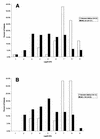Comparison of two culture methods for detection of tobramycin-resistant gram-negative organisms in the sputum of patients with cystic fibrosis
- PMID: 11773088
- PMCID: PMC120123
- DOI: 10.1128/JCM.40.1.26-30.2002
Comparison of two culture methods for detection of tobramycin-resistant gram-negative organisms in the sputum of patients with cystic fibrosis
Abstract
A culture method utilizing quantitative plating on antibiotic-containing media has been proposed as a technique for the detection of tobramycin-resistant organisms that is more sensitive than standard methods. Typical sputum culture methods quantitate the relative amounts of each distinct morphotype, followed by antibiotic susceptibility testing of a single colony of each morphotype. Sputum specimens from 240 cystic fibrosis patients were homogenized, serially diluted, and processed in parallel by the standard method (MacConkey agar and OF basal medium with agar, polymyxin, bacitracin, and lactose) and by plating on antibiotic-containing media (MacConkey agar with tobramycin added at 25 microg/ml [MAC-25] and 100 microg/ml [MAC-100]). MICs of tobramycin were determined for all Pseudomonas aeruginosa isolates by broth microdilution. Growth of P. aeruginosa on MAC-25 was considered to be equivalent to a tobramycin MIC of > or = 16 microg/ml, and growth on MAC-100 was considered to be equivalent to a tobramycin MIC of > or = 128 microg/ml. Analysis of method-specific detection rates showed that tobramycin-containing medium was more sensitive than the standard method for the detection of tobramycin-resistant P. aeruginosa, Stenotrophomonas maltophilia, and Achromobacter xylosoxidans but was less sensitive for the detection of Burkholderia cepacia than the standard method. When MICs for P. aeruginosa that grew on tobramycin-containing medium were tested by broth microdilution, the MICs for 28 of 121 strains (23%) growing on MAC-25 and 22 of 56 strains (39%) growing on MAC-100 were MICs < 16 and < 128 microg/ml, respectively. Addition of a tobramycin-containing MacConkey plate to the routine media for sputum culture may provide additional, clinically relevant microbiologic data.
Figures


Similar articles
-
Facilitated detection of antibiotic-resistant Pseudomonas in cystic fibrosis sputum using homogenized specimens and antibiotic-containing media.Diagn Microbiol Infect Dis. 1986 Nov;5(4):299-305. doi: 10.1016/0732-8893(86)90032-5. Diagn Microbiol Infect Dis. 1986. PMID: 3096628
-
Pitfalls of polymyxin antimicrobial susceptibility testing of Pseudomonas aeruginosa isolated from cystic fibrosis patients.J Antimicrob Chemother. 2004 Dec;54(6):1057-61. doi: 10.1093/jac/dkh470. Epub 2004 Oct 27. J Antimicrob Chemother. 2004. PMID: 15509615
-
Use of artificial sputum medium to test antibiotic efficacy against Pseudomonas aeruginosa in conditions more relevant to the cystic fibrosis lung.J Vis Exp. 2012 Jun 5;(64):e3857. doi: 10.3791/3857. J Vis Exp. 2012. PMID: 22711026 Free PMC article.
-
Antibiotic treatment of multidrug-resistant organisms in cystic fibrosis.Am J Respir Med. 2003;2(4):321-32. doi: 10.1007/BF03256660. Am J Respir Med. 2003. PMID: 14719998 Review.
-
Inhaled tobramycin (TOBI): a review of its use in the management of Pseudomonas aeruginosa infections in patients with cystic fibrosis.Drugs. 2003;63(22):2501-20. doi: 10.2165/00003495-200363220-00015. Drugs. 2003. PMID: 14609360 Review.
Cited by
-
Single-molecule long-read 16S sequencing to characterize the lung microbiome from mechanically ventilated patients with suspected pneumonia.J Clin Microbiol. 2014 Nov;52(11):3913-21. doi: 10.1128/JCM.01678-14. Epub 2014 Aug 20. J Clin Microbiol. 2014. PMID: 25143582 Free PMC article.
-
Utility of gram staining for evaluation of the quality of cystic fibrosis sputum samples.J Clin Microbiol. 2002 Aug;40(8):2791-4. doi: 10.1128/JCM.40.8.2791-2794.2002. J Clin Microbiol. 2002. PMID: 12149331 Free PMC article.
References
-
- Barclay, M. L., E. J. Begg, S. T. Chambers, P. E. Thornley, P. K. Pattemore, and K. Grimwood. 1996. Adaptive resistance to tobramycin in Pseudomonas aeruginosa lung infection in cystic fibrosis. J. Antimicrob. Chemother. 37:1155–1164. - PubMed
-
- Bryan, L. E., A. J. Godfrey, and T. Schollardt. 1985. Virulence of Pseudomonas aeruginosa strains with mechanisms of microbial persistence for β-lactam and aminoglycoside antibiotics in a mouse infection model. Can. J. Microbiol. 31:377–380. - PubMed
-
- Burns, J. L., J. M. Van Dalfsen, R. M. Shawar, K. L. Otto, R. L. Garber, J. M. Quan, A. B. Montgomery, G. M. Albers, B. W. Ramsey, and A. L. Smith. 1999. Effect of chronic intermittent administration of inhaled tobramycin on respiratory microbial flora in patients with cystic fibrosis. J. Infect. Dis. 179:1190–1196. - PubMed
-
- Geers, T. A., and N. R. Baker. 1987. The effect of sublethal concentrations of aminoglycosides on adherence of Pseudomonas aeruginosa to hamster tracheal epithelium. J. Antimicrob. Chemother. 19:561–568. - PubMed
-
- Gerber, A. U., and W. A. Craig. 1982. Aminoglycoside-selected subpopulations of Pseudomonas aeruginosa: characterization and virulence in normal and leukopenic mice. J. Lab. Clin. Med. 100:671–681. - PubMed
Publication types
MeSH terms
Substances
LinkOut - more resources
Full Text Sources
Medical
Research Materials
Miscellaneous

